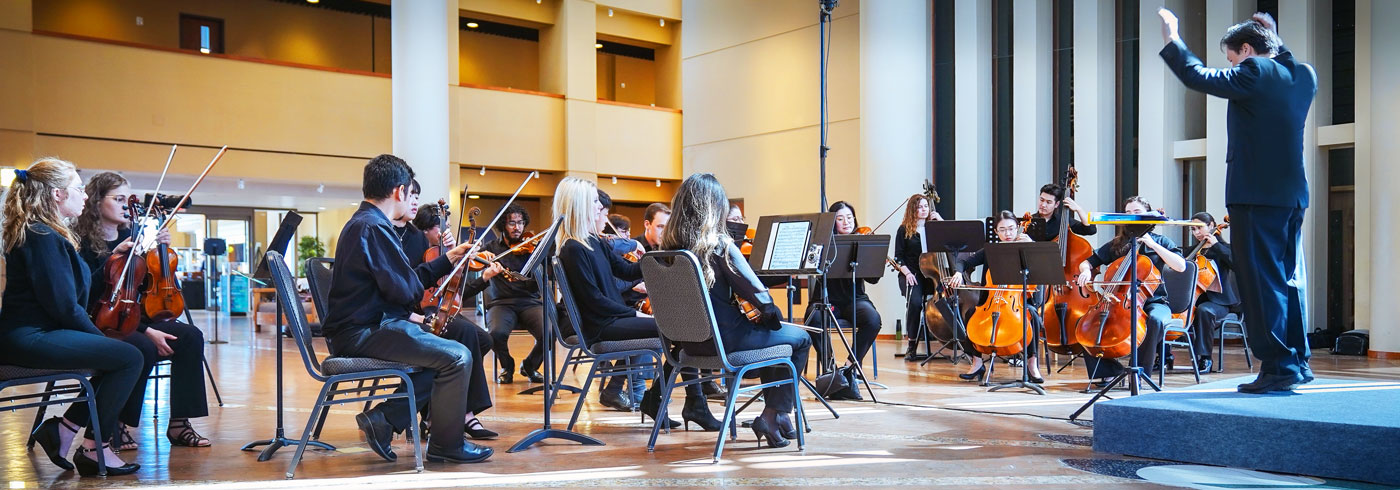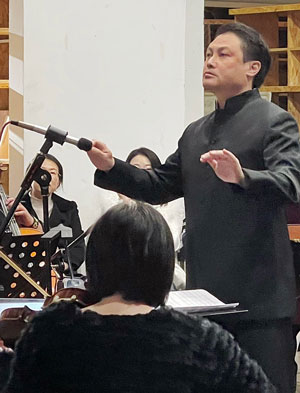The Musicians!
Strings
Woodwind
This professional orchestra is made up of musicians that are highly trained. Most of the chamber members are either music professors or local professional symphony musicians. The combination of these qualities of such an august group brings the best of Oklahoma City talent to perform music that must be seen.

Photograph by Di Harvell. Enhancement by HDG.
Viola
The First Chair Violist
The viola offers an elegant and sensual harmony. The size, weight, and bow pressure of violas make them more challenging to learn by a violist. Since the notes are spread out farther along the fingerboard a great deal of dexterity is required.
Violin
The First Chair Violinist
The concertmaster, or first chair violinist, is an essential musical figure with a wide range of duties, including orchestra tuning and close collaboration with the conductor.
Cello
The Cellist
Cello is just a nickname. It is an acronym for the full word violoncello, which translates to small large viol in Italian. Cellos or celli are both acceptable plural forms. Also known as a violoncellist is someone who plays the cello. The cello produces stunning, warm, vibrant tones and full sounds.
Double Bass
The Double Bassist
In the contemporary symphony orchestra, the double bass is the largest and lowest-pitched bowed string instrument. The double bass is often known as the string bass, contrabass, upright bass, or acoustic bass
Violins & Violas
The Second Chair Violinist
The second chair, and occasionally the third and fourth chairs, are referred to as assistant concertmasters. When necessary, they must fill in for the concertmaster.
The Violinist
To play the violin, a great level of skill is needed. It requires years of effort and dedication to master because not everyone can pick one up and start playing.
The Violist
To play the viola, a musician must have superior hearing, sensitive to the intonation, sound quality, and harmony.
Orchestra Traditions
Because the audience wants to focus on the music, not the orchestra members, the musicians dress in black. Many fans of classical music feel that the artists themselves should not be the least bit distracting from the music. An orchestra requires a team to play.
You might see the musicians shuffling their feet when one of their fellow players finishes a solo. They use that as a means to express, “Great job! Instead of waiting until the end to applaud them, which allows the piece to continue.
Because every string instrument has a “A” string, orchestras usually tune to one note. At the start and conclusion of each concert, the conductor will shake hands with the concertmaster to greet or thank the full orchestra. It is an expression of cooperation and a custom of respect.
Virtuoso is a solo violinist. In the world of classical music, soloists are accomplished musicians who perform with various orchestras as the main attraction while touring from city to city.

Woodwinds
The Flautist
A musician blows into a thin edge of the tube-shaped, reedless wind instrument known as a flute while holding it vertically or horizontally. The modern orchestral form is horizontally held and includes a complex set of keys. It is often constructed of metal.
The Oboist
An oboe is played by blowing into the double reed, causing the two reeds to vibrate against one another and produce sound. Oboists in the profession craft their own cane reeds by hand.
The Clarinetist
One of the more modern woodwind instruments is the clarinet. The clarinet has a single-reed mouthpiece, a basic, straight tube with complex keys, and a flared, bell-shaped end. The clarinetist blows into the mouthpiece using their fingers to make the notes on the keys.
